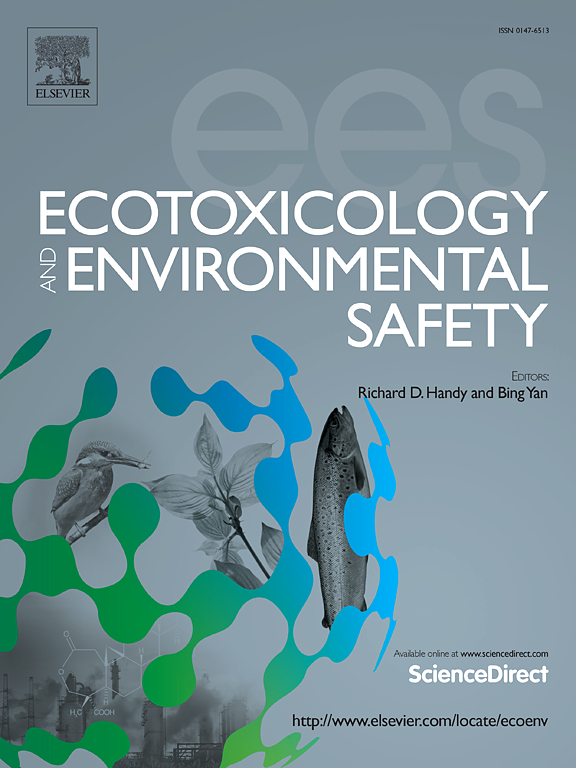有毒金属和微量元素,炎症标志物,女性高雄激素血症和男性睾酮缺乏:关联和潜在的中介因素
IF 6.2
2区 环境科学与生态学
Q1 ENVIRONMENTAL SCIENCES
引用次数: 0
摘要
有证据表明,接触有毒金属和微量元素会破坏雄激素水平。然而,这种暴露对女性高雄激素血症(HA)和男性睾酮缺乏症(TD)的具体影响尚不清楚。该研究调查了有毒金属和微量元素暴露与女性HA和男性TD之间的关系,利用了2013年至2016年进行的国家健康和营养检查调查(NHANES)的数据,包括2205名女性和2621名男性。单次暴露分析发现,铅(Pb)(调整优势比[aOR] 1.19, 95 %可信区间[CI] 1.04-1.36)和镉(Cd)(调整优势比[aOR] 1.20, 95 % CI 1.03-1.39)与血凝素呈正相关,尤其是35岁以上的女性。锰(Mn)与TD呈正相关(aOR 1.15, 95 % CI 1.03-1.28),在45 - 50岁的男性和肥胖男性中尤为明显。采用分组加权分位数和(GWQS)模型评估组合暴露的影响,发现有毒金属混合物与HA呈正相关,特别是Cd(0.59)和Pb(0.40),微量元素混合物与TD呈正相关,特别是Mn(0.78)。中介分析表明炎症,特别是单核细胞计数和碱性磷酸酶(ALP)介导了7.5-11.76 %的关联。这些发现为减少暴露的干预措施提供了见解。本文章由计算机程序翻译,如有差异,请以英文原文为准。
Toxic metals and trace elements, markers of inflammation, and hyperandrogenemia in women and testosterone deficiency in men: Associations and potential mediating factors
There is evidence suggesting that toxic metal and trace element exposure disrupts androgen levels. However, specific effects of such exposure on hyperandrogenemia (HA) in women and testosterone deficiency (TD) in men remain unclear. The study investigated associations between toxic metal and trace element exposure and HA in women and TD in men, utilizing data from the National Health and Nutrition Examination Survey (NHANES) conducted between 2013 and 2016, and included 2205 women and 2621 men. Single-exposure analyses found lead (Pb) (adjusted odds ratio [aOR] 1.19, 95 % confidence interval [CI] 1.04–1.36) and cadmium (Cd) (aOR 1.20, 95 % CI 1.03–1.39) were positively associated with HA, especially strong in women over the age of 35. Manganese (Mn) was positively associated with TD (aOR 1.15, 95 % CI 1.03–1.28), especially strong in men aged between 45 and 50 years and obese men. A grouped weighted quantile sum (GWQS) model was performed to assess the effects of combined exposure, and found toxic metal mixture was positively associated with HA, particularly Cd (0.59) and Pb (0.40), and trace element mixture was positively associated with TD, particularly Mn (0.78). Mediation analyses demonstrated inflammation, particularly monocyte count and alkaline phosphatase (ALP) mediated 7.5–11.76 % of the associations. These findings provide insights to inform interventions for reducing exposure.
求助全文
通过发布文献求助,成功后即可免费获取论文全文。
去求助
来源期刊
CiteScore
12.10
自引率
5.90%
发文量
1234
审稿时长
88 days
期刊介绍:
Ecotoxicology and Environmental Safety is a multi-disciplinary journal that focuses on understanding the exposure and effects of environmental contamination on organisms including human health. The scope of the journal covers three main themes. The topics within these themes, indicated below, include (but are not limited to) the following: Ecotoxicology、Environmental Chemistry、Environmental Safety etc.

 求助内容:
求助内容: 应助结果提醒方式:
应助结果提醒方式:


